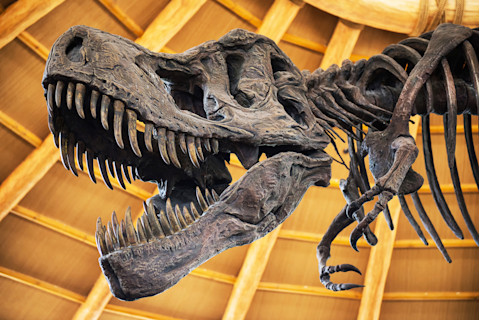
The word dinosaur may mean “terrible lizard” in Greek, but these creatures may have had a lot more in common with warm-blooded animals than their cold-blooded name implies. Paleontologist Michael D’Emic, in a new study, says he’s found evidence in dinosaur bones that indicates these ancient creatures were fully warm-blooded. D’Emic arrived at this conclusion after reexamining findings from a widely publicized 2014 study that concluded dinosaurs were neither cold- nor warm-blooded, but a hybrid of both categories. D’Emic’s theory represents another chapter in a dino debate that’s been waged by scientists since the 19^th century.
Revisiting the Data
In last year’s study, published in Science, researchers evaluated the metabolism of 21 dinosaur species by building a formula based on dinosaurs’ body mass (indicated by the size of thigh bones) and growth rates (indicated by rings in fossils). Growth rings, like tree rings, demarcate periods of arrested growth, while the spaces between rings indicate periods of rapid growth. Researchers then used these rings to estimate different dinosaur species’ daily growth rates, and compared their findings to modern-day warm-blooded animals. They concluded that dinosaur growth rates weren’t characteristic of either warm- or cold-blooded animals, and were instead most similar to mesotherms — animals that can regulate body temperature, but their internal temperature doesn’t remain fixed. Only a few existing species are mesotherms, including some sharks and turtles. But researchers’ daily growth rate formula assumed dinosaurs grew at a constant rate each year. However, D’Emic points out that dinosaurs probably grew sporadically, packing on the pounds during brief wet periods when food was abundant, and halting their growth during dry periods, for example. The space between growth rings may represent only a few months, rather than an entire year as last year’s study indicated, D’Emic claims.
D’Emic believes researchers underestimated the speed at which dinosaurs grew, and, instead, dinosaur growth rates were far more similar to modern-day mammals. Thus, D’Emic concludes, dinosaurs were warm-blooded, not mesotherms. His findings were published as a commentary in Science on May 29.
Another Round of Debate
The authors of last year’s study aren’t convinced by D’Emic’s reanalysis. "We disagree with his central criticisms and we emphasize that all of our original conclusions stand," University of New Mexico biologist and study author John Grady told Reuters. "Comparing dinosaur growth with the observed growth rate of living vertebrates clearly shows that non-avian dinosaurs were mesotherms," To be clear, scientists still are still working out the best technique for accurately estimating dinosaur growth rates, and that work may yield a more varied perspective of dinosaur physiology. In other words, D’Emic and Grady could both be right, as National Geographic’s Brian Switek writes:
This is more likely to lead to a picture of variable dinosaurs than a saurian standard. It would actually be surprising if all dinosaurs… shared the same physiology.
Holly Woodward, an assistant professor of anatomy and vertebrate paleontology at Oklahoma State University, said in a statement last week that D’Emic’s reanalysis is another important step toward a better understanding of dinosaur physiology. “D’Emic’s study reveals how important access to the data behind published results is for hypothesis testing and advancing our understanding of dinosaur growth dynamics,” Woodward said. Meanwhile, D’Emic hopes to further test his theory by analyzing the bones of a wider sampling of dinosaur species than were included in the original study.
Photo credit: kikujungboy/Shutterstock













